#GISMap
Explore tagged Tumblr posts
Text

Ubah Data GPS Jadi Visualisasi Peta di QGIS 3 di UDEMY
Pelajari langkah demi langkah pemrosesan data GPS menggunakan QGIS.
Diskon 54% (Rp 129K dari Rp 279K)
0 notes
Text

This is WAY different from my usual art, but I'm posting it anyway! I start GIS masters soon and before then I'm practicing making maps in Esri tutorial projects. I'm trying to do one a day, or at least like every other day. This Arctic Sea Ice Decline map took me around 4-5 hours to make, and I changed it from the instructions because I wanted clearly defined decade chunks rather than a gradient map of ice presence over time lol (also just wanted to see if I remembered how to do it). The tutorial provides data sets to use and it's my job to assemble and analyze the raw data and visualize it using ArcPro into something recognizable.
but yea expect to see more little maps n such I suppose
#art#is this art? Im saying it is#arcgispro#arcpro#map#mapping#maps#arctic#arctic ice#ice#environment#environmental science#aesthetic#wyyrmwood#gis#gismapping#digital#ice cover#data#datascience#data analytics#computer science
6 notes
·
View notes
Text




👉 Beneath the Himalayas: Unveiling the Underwater Secrets of Jammu & Kashmir with Bathymetric Surveys ✅ Bathymetric Survey in Jammu & Kashmir plays a vital role in understanding the intricate underwater terrain of this ecologically rich and strategically significant region. Jammu & Kashmir’s water bodies—from the lofty alpine lakes like Dal and Wular to the glacier-fed rivers such as the Chenab and Jhelum—serve purposes far beyond their breathtaking beauty. Call : +91 8074692090 Visit : https://slokainfrasolutions.com/blogs/bathymetric-survey-in-jammu-kashmir/
#BathymetricSurvey#UnderwaterMapping#HydrographicSurvey#LakeMapping#GeospatialData#InfrastructureDevelopment#SmartSurveying#EnvironmentalMonitoring#RemoteSensing#GISMapping#SlokaInfraSolutions#DepthMeasurement#SonarTechnology#WaterbodyMapping#SeabedSurvey#SurveyTechnology#JammuAndKashmir#Himalayas#JKTourism#KashmirLakes#IndianGeography#HimalayanWaters
2 notes
·
View notes
Text
Mapping Stories That Matter: Exploring Culture with Interactive Story Maps
Stories aren’t just found in books—they unfold around us every day. In the rhythms of daily life, in the spaces we move through, meaning is constantly created. Interactive story maps help capture that depth—not just showing where things happen, but why they matter.

Beyond Pins and Text: Why Story Maps Make a Difference
Interactive story maps created on platforms like MAPOG blend spatial data with visual storytelling. Whether it’s showcasing monuments, documenting community spaces, or mapping cultural festivals, story maps provide dynamic, multimedia-rich experiences. Each point on the map becomes a micro-story, complete with descriptions, images, and meaningful context.
Instead of a static document or a plain PDF, a story map lets users explore data intuitively—zooming into areas, reading histories, and drawing connections between places and their cultural significance.
The Challenge with Traditional Methods
Spreadsheets, reports, and slide decks may convey facts, but they rarely spark curiosity. They miss the visual relationships between locations, and they’re hard to interact with. By contrast, story maps let you see clusters, patterns, and trends. For example: Where are India’s Buddhist sites concentrated? What colonial buildings align with old trade routes? You can't spot that in a list—but you can on a map.
Who Benefits from Story Mapping?
Creating a story map using MAPOG isn’t just a tech activity—it’s a cultural tool that serves:
Educators & Students: Bringing history and geography to life in classrooms through visual journeys.
Tourism Boards: Highlighting cultural circuits and local heritage trails to inspire travelers.
NGOs & Researchers: Mapping social initiatives or heritage restoration projects spatially and clearly.
Content Creators: Building engaging blogs, portfolios, or exhibits with embedded interactive narratives.

A New Way to Connect with Culture
By turning data into narrative and maps into experiences, story maps do more than display—they communicate. They help us see patterns we hadn’t noticed before. And more importantly, they make heritage, culture, and community stories more approachable, discoverable, and memorable.
In an era where visual storytelling is more impactful than ever, story maps empower us to map what truly matters—from ancient ruins to modern social movements. With tools like MAPOG, it’s never been easier to create and share stories that are grounded in place and rich in meaning.
Your story deserves a map—and the world deserves to see it.
4 notes
·
View notes
Text
How to Add CSV Data to an Online Map?
Introduction
If you're working with location-based data in a spreadsheet, turning it into a map is one of the most effective ways to make it visually engaging and insightful. Whether you're planning logistics, showcasing population distribution, or telling a location-driven story, uploading CSV (Comma-Separated Values) files to an online mapping platform helps simplify and visualize complex datasets with ease.

🧩 From Spreadsheets to Stories
If you've ever worked with spreadsheets full of location-based data, you know how quickly they can become overwhelming and hard to interpret. But what if you could bring that data to life—turning rows and columns into interactive, insightful maps?
📌 Why Map CSV Data?
Mapping CSV (Comma-Separated Values) data is one of the most effective ways to simplify complex datasets and make them visually engaging. Whether you're analyzing population trends, planning delivery routes, or building a geographic story, online mapping platforms make it easier than ever to visualize the bigger picture.
⚙️ How Modern Tools Simplify the Process
Modern tools now allow you to import CSV or Excel files and instantly generate maps that highlight patterns, relationships, and clusters. These platforms aren’t just for GIS professionals—anyone with location data can explore dynamic, customizable maps with just a few clicks. Features like filtering, color-coding, custom markers, and layered visualizations add depth and context to otherwise flat data.
📊 Turn Data Into Actionable Insights
What’s especially powerful is the ability to analyze your data directly within the map interface. From grouping by categories to overlaying district boundaries or land-use zones, the right tool can turn your basic spreadsheet into an interactive dashboard. And with additional capabilities like format conversion, distance measurement, and map styling, your data isn't just mapped—it's activated.
🚀 Getting Started with Spatial Storytelling
If you're exploring options for this kind of spatial storytelling, it's worth trying platforms that prioritize ease of use and flexibility. Some tools even offer preloaded datasets and drag-and-drop features to help you get started faster.
🧭 The Takeaway
The bottom line? With the right platform, your CSV file can become more than just data—it can become a story, a strategy, or a solution.
Practical Example
Let’s say you have a CSV file listing schools across a country, including their names, coordinates, student populations, and whether they’re public or private. Using an interactive mapping platform like the one I often work with at MAPOG, you can assign different markers for school types, enable tooltips to display enrollment figures, and overlay district boundaries. This kind of layered visualization makes it easier to analyze the spatial distribution of educational institutions and uncover patterns in access and infrastructure.
Conclusion
Using CSV files to create interactive maps is a powerful way to transform static data into dynamic visual content. Tools like MAPOG make the process easy, whether you're a beginner or a GIS pro. If you’re ready to turn your spreadsheet into a story, start mapping today!
Have you ever mapped your CSV data? Share your experience in the comments below!
4 notes
·
View notes
Text
#gsourcetechnologies#engineeringservices#architectureservices#GISmapping#geographic information system#cadastralmapping#utility mapping#map digitization
2 notes
·
View notes
Text
Map Smart: Solve Real-World Challenges with Free GIS Tools for Students & Researchers

In today’s data-driven world, free GIS mapping tools empower students and researchers to visualize, analyze, and solve spatial problems with confidence. Using online platforms, geographic data becomes a dynamic resource for educational planning, strategic development, and community-based research.
Why Use GIS to Plan Real-World Infrastructure Like Hospitals? Understanding both spatial access and service gaps is essential in planning hospitals, especially in underserved or high-density regions. GIS tools simplify complex decisions and help users explore key questions like:
Which areas lack access to nearby healthcare facilities?
What’s the travel time for patients during emergencies?
Which zones meet criteria for safety, accessibility, and land use?
By layering data (roads, population, terrain, land use) and applying tools like buffers, isochrones, and clip operations, planners can make smart, data-backed site choices.
Key Benefits of GIS Mapping in Education and Research 🔍 Spatial Awareness – Understand how geography influences access to healthcare. 📊 Data Analysis Skills – Work with real datasets to uncover service gaps. 🌍 Cross-Disciplinary Learning – Apply GIS across public health, planning, and urban studies. 🛠️ Practical Tools – Use no-code features like buffer zones and travel-time maps. 📚 Applied Research – Simulate hospital planning scenarios to guide real decisions.
How to Create a Smart Mapping Project
Start a new story and load the GIS data layers: “Transportation: airport,” “Land Use: land,” and “Industrial: warehouse.” Choose your area of interest by navigating from country to state to district. Use the Buffer Tool under the process data menu to create 5 km zones around airports, labeling them as “Airport Proximity Zones.” Next, apply the Isochrone Tool under the process data to highlight regions accessible within 60 minutes via the road network and name them “Travel Zones.” Then, use the Clip Tool under the process data to identify areas where these two zones intersect and save the output as “Overlapped Zones.” Within these zones, select 5 warehouse locations using the Add Points feature, and include attributes like name, area (in sq. ft.), an image, and the measured distance to the nearest airport using the Measure Tool. Customize each point with appropriate icons and labels. Finally, publish and share your completed interactive map for use in education or research.

Open Tools, Real Applications Free GIS platforms like MAPOG bring professional-level tools to students, educators, and civic planners. With drag-and-drop layers and visual editing, they’re ideal for:
Public healthcare facility planning
Emergency service accessibility analysis
Civic tech and classroom use
Group-based student research
Educational Impact and Use Case This kind of mapping activity brings theory to life. Students build:
Real-world spatial thinking and planning skills
Familiarity with GIS tools used in healthcare services
Portfolio-worthy projects in applied research
GIS becomes a powerful connector across domains from public health and geography to urban planning and social impact.
Conclusion Free GIS tools transform complex public health planning problems like selecting new hospital sites into clear, data-informed strategies. By integrating layered data with spatial tools and practical workflows, students and researchers can tackle urgent, real-world questions with purpose.
🌐 Ready to plan smarter? Try a GIS platform for your research project and start building your hospital site selection project today.
#GISMapping#EducationTools#DataVisualization#FreeGIS#MAPOG#UrbanPlanning#StudentProjects#InteractiveMaps#GeospatialTech#EdTech
0 notes
Text
🌱 Using GIS Tools to Identify Best Sites for Organic Farming and Increase Yield
📍 Introduction
Let’s face it—finding the perfect spot for organic farming isn’t just about green fields and good vibes. It’s about data. As organic farming becomes more essential in our sustainable future, selecting the right piece of land can make or break your farm’s success. That’s where GIS tools come in.

🧠 Key Concepts
So, what’s GIS? Geographic Information Systems (GIS) are tools that capture, analyze, and visualize spatial data. Think layers of information—soil quality, rainfall, terrain, land use—all stacked together to help you make smart decisions.
And when you’re growing organic? Every factor counts.
🌾 How GIS Supports Organic Farming
Using GIS, you can:
➡️ Map out soil types and moisture levels ➡️ Analyze slope and sunlight exposure ➡️ Perform buffer analysis to stay clear of pollutants (like roads or residential zones) ➡️ Merge layers to see the full picture—where all the right conditions align
Tools like MAPOG make this super accessible. You don’t need to be a cartographer—just upload your data, run your buffers, and start mapping your future farm.
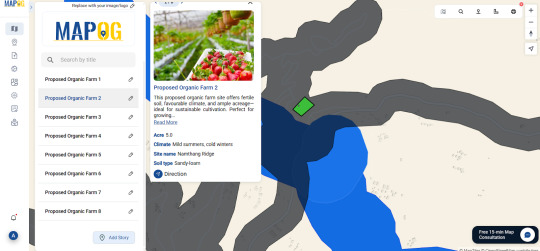
🧑🌾 Who’s Using This?
Local agriculture departments are using GIS to zone out regions for organic certifications
NGOs and environmental groups rely on it to advocate for sustainable land use
Organic certification bodies trace farm origins and verify compliance
Even policy makers use it to shape subsidies and district-level irrigation schemes
✅ Conclusion
In a world where sustainable choices matter more than ever, GIS isn’t just a tech buzzword—it’s a real game-changer for agriculture. Whether you're just exploring or already knee-deep in compost, GIS tools can help you farm smarter, not harder.
✨ Ready to see your land differently? Tools like MAPOG can help you start mapping your organic vision today.
0 notes
Text
How GIS Helps in Identifying High-Growth Areas for Real Estate Investment
In an ever-changing real estate landscape, identifying areas poised for rapid development isn't just a competitive advantage—it's a necessity. Traditional methods of forecasting growth often fall short in addressing the complex interplays of infrastructure, demographics, and access to essential amenities. That's where Geographic Information Systems (GIS) step in as a transformative force.
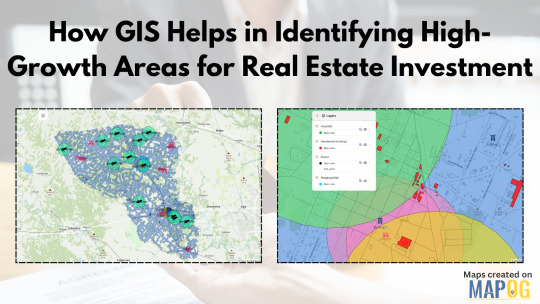
GIS as the Eye Behind Data-Driven Real Estate
GIS technology allows users to visualize and analyze layers of geographic and statistical data all in one view. From traffic congestion and transportation routes to proximity to hospitals, schools, malls, and airports—all of this can be layered spatially to make more informed investment decisions. For real estate developers, this is more than just data; it's a dynamic decision-making tool.
By using GIS, stakeholders can map out locations with strategic access to critical infrastructure. Suppose you're analyzing a city for future residential projects. You could create buffers around public transit lines, shopping centers, and educational institutions to isolate high-potential zones. These buffers offer clarity where raw data often fails to paint the full picture.
Solving the Real Estate Guesswork
One of the biggest pain points in real estate is uncertainty: will a particular neighborhood rise in value? Will upcoming infrastructure really influence demand? GIS helps answer those questions by showing not just what exists, but how it interacts across space and time. For instance, you could track development permits over time or visualize environmental constraints like flood zones or green cover. These insights are crucial for mitigating risk and spotting overlooked opportunities.
Industries like urban planning, government housing departments, logistics, and commercial development firms increasingly rely on GIS to plan smarter. Even small-scale investors are catching on, thanks to platforms that simplify GIS applications into more user-friendly formats.
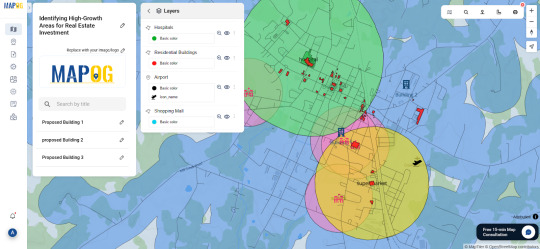
One Platform, Many Possibilities
Some mapping tools now let you not only import transportation and amenities data but also define your area of interest, set proximity buffers, and drop pins for future projects. You can even share interactive maps with teams or stakeholders. One such example is a GIS platform like MAPOG, which simplifies the entire GIS workflow from analysis to visualization without needing deep technical skills.
Whether you're evaluating urban corridors for commercial hubs or scoping out suburban areas for housing, GIS offers the clarity you need. Try exploring platforms like MAPOG if you're looking for a seamless way to start.
#realestateinvestment#gis#mapog#gismapping#smartcities#urban planning#urban growth#mapping#data visualization#spatial analysis#propertydevelopment
0 notes
Text
How GIS Is Reimagining Historical Battles and War Sites
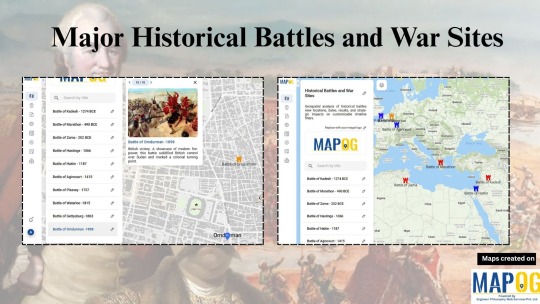
History doesn’t just happen, it happens somewhere. Every great battle, from ancient times to modern wars, unfolded across real terrain. And yet, we often learn about war without ever understanding the land that shaped it. That’s where Geographic Information Systems (GIS) step in, offering a way to map the past and see history in a whole new dimension.
Whether it’s the Battle of Thermopylae, Hastings, or Stalingrad, GIS helps us explore not just what happened, but where and why it mattered.
Seeing Strategy Through Space
Using GIS tools, we can now visualize battlefield locations, terrain advantages, movement routes, and areas of control. In one of my recent projects using MAPOG, I plotted a timeline of key battles across ancient, medieval, and modern periods. Each point told a story of strategy, geography, and impact.

I added elevation data to understand why armies chose certain high ground. I layered historical sites with modern maps to trace how landscapes have changed over centuries. The result? A living, visual archive of human conflict across time.
Why It Matters: Turning History into Experience
GIS doesn’t just make maps — it makes arguments visible. It shows:
Why a river crossing changed a war
How a forest slowed an army’s advance
Where supply lines ran thin
Which battlegrounds are now forgotten beneath cities
These aren’t just cool visuals, they help students, educators, and researchers tell more complete and compelling stories about war and human history.
Who Uses GIS to Map War?
Today, GIS is being used by archaeologists, military historians, museum curators, and even students working on school projects. The beauty? You don’t need to be a mapping expert.
Platforms like MAPOG let you drop pins, color-code eras, upload visuals, and organize battles into eras all in a few clicks. You can focus on the storytelling, not the software.
Making It Easy with Tools Of GIS
I used MAPOG List View Map to organize battles chronologically. With symbols for each conflict and color codes for different eras (Red for Ancient, Blue for Medieval, Orange for Modern), the map turned into a timeline across geography.
MAPOG made it easy to:
Add point , add title write description
Add photos, summaries, and custom labels
Explore terrain using satellite overlays
Share the final map with friends, students, or an audience

If you’re into history, this is the kind of project that makes the past feel alive again.
Conclusion: Seeing the Past, Shaping the Future
History isn’t just what happened. It’s where it happened and understanding that can change how we learn, teach, and remember.

With GIS, we’re not just reading about wars, we’re exploring them, walking their paths, and seeing their impact. So if you’ve ever wanted to time-travel through maps, start with a project like this. Use GIS, use MAPOG, and turn names and dates into living stories on the land.
1 note
·
View note
Text
Ubah Data GPS Jadi Visualisasi Peta di QGIS 3 di UDEMY
Pelajari langkah demi langkah pemrosesan data GPS menggunakan QGIS.
Diskon 54% (Rp 129K dari Rp 279K)
0 notes
Text
Transform Property Management with Accurate Survey and GIS Mapping Solutions
At CyberSWIFT, we offer comprehensive Property Survey and GIS Mapping services that support accurate land administration, infrastructure planning, and real estate development. Our solutions are designed to meet the needs of government bodies, urban development authorities, infrastructure agencies, and private organizations seeking precision and clarity in land-related data.

Get a free consultation: https://www.cyberswift.com/in/industries/urban-gis-solutions
Our Key Offerings Include:
📍High-precision cadastral and topographical surveys
📍GIS-based property boundary mapping and parcel-level data visualization
📍Digitization of land records for easy retrieval and management
📍Integration of spatial data with decision-support systems
📍Identification of encroachments and resolution of property disputes
📍Scalable solutions for urban, semi-urban, and rural areas
By combining advanced survey techniques with geospatial intelligence, CyberSWIFT ensures that land and property information is not only accurate but also actionable. Our team ensures adherence to local regulations and industry standards to support legal compliance and efficient land governance.
#PropertySurvey#GISMapping#LandRecordsManagement#GeospatialServices#DigitalLandRecords#UrbanPlanning#InfrastructureMapping#CyberSWIFT
0 notes
Text

DGPS Survey Services In Amritsar
Unlock Precision and Accuracy with DGPS Survey Services by City Scape Planners Inc.
In the ever-evolving landscape of land surveying and geospatial mapping, precision and accuracy are non-negotiable. City Scape Planners Inc. stands at the forefront of cutting-edge surveying technology, offering top-tier Differential Global Positioning System (DGPS) Survey Services across Punjab and beyond.
Why Choose DGPS Surveying?
DGPS is an advanced positioning system that significantly enhances the accuracy of standard GPS by using differential corrections. It plays a crucial role in: ✔️ Land demarcation and boundary surveys ✔️ Infrastructure development and town planning ✔️ Agricultural and forestry mapping ✔️ Roadway and transportation projects ✔️ Utility and pipeline alignment studies ✔️ Coastal and hydrographic surveys
City Scape Planners Inc. – Your Trusted Survey Partner
With a team of experienced professionals and state-of-the-art surveying equipment, City Scape Planners Inc. ensures high-precision, reliable, and cost-effective DGPS survey solutions tailored to meet diverse project needs. Our expertise guarantees: ✅ Accurate geospatial data collection ✅ Rapid execution with minimal errors ✅ Compliance with government and industry standards ✅ Customized solutions for complex terrains and large-scale projects
Industries We Serve
Our DGPS survey services cater to a wide range of sectors, including: 🏗️ Construction & Real Estate 🌍 Environmental Studies 🛣️ Road & Highway Planning 🏭 Industrial Development 🌾 Agricultural Land Assessment 💧 Water Resource Management
Get the Best Surveying Solutions Today!
When it comes to precision-driven land surveying, City Scape Planners Inc. is your go-to expert. Trust us for flawless mapping, accurate results, and expert guidance every step of the way.
🌐 Visit: City Scape Planners Inc. - DGPS Survey
#DGPS#DGPSSurvey#LandSurveying#GeospatialMapping#CityScapePlanners#SurveyingServices#LandDemarcation#InfrastructureDevelopment#TopographicSurvey#ConstructionSurvey#GISMapping#PrecisionSurvey#RealEstateSurvey#UrbanPlanning#AgriculturalMapping#RoadwaySurvey#HydrographicSurvey#PipelineSurvey#SurveyExperts#PunjabSurveyServices#Amritsar#Infra
0 notes
Text
Unveiling the Depths: Bathymetric Survey Transforming Himachal Pradesh’s Waterways
Bathymetric Survey in Himachal Pradesh plays a pivotal role in unveiling the hidden contours of the state’s myriad water bodies, from high-altitude glacial lakes to meandering rivers and serene reservoirs.. Call : +91 8074692090 Visit : https://slokainfrasolutions.com/blogs/bathymetric-survey-in-himachal-pradesh/
#SlokaInfraSolutions#BathymetricSurvey#HydrographicSurvey#UnderwaterMapping#WaterDepthAnalysis#SonarSurvey#LakeMapping#RiverSurvey#SeabedMapping#SurveyTechnology#GeospatialSurvey#HimachalPradesh#HimalayanRivers#ExploreHimachal#SmartInfrastructure#EnvironmentalMapping#GISMapping
0 notes
Text
Mapping Waste Disposal Sites: Visualizing Sanitation Infrastructure for Cleaner Cities
Effective waste management is not simply about collecting garbage—it's critical for public health, environmental sustainability, and urban livability. As Indian cities continue to expand, clearly understanding where waste disposal facilities are and how effectively they're managed is essential. Traditional data formats such as lists and tables provide useful information, but they fail to convey the geographic nuances necessary for targeted improvements. Spatial mapping bridges this gap, offering vital visual insights into waste management infrastructure.

Why Spatial Mapping of Waste Matters
Spatial mapping transforms waste management data into visual, geographic insights. By utilizing Geographic Information Systems (GIS) platforms such as MAPOG, urban planners, policymakers, and communities can precisely visualize locations and conditions of facilities including landfills, recycling units, refuse transfer stations, and public waste bins. This approach reveals patterns, highlights effective practices, and clearly identifies areas that require immediate attention.
Limitations of Traditional Reporting
While conventional reporting methods offer valuable statistics, they often miss critical geographic details. Static reports cannot illustrate the spatial relationships between waste facilities and surrounding neighborhoods, nor can they easily communicate the impact of regional factors on waste management outcomes. Spatial maps effectively communicate these geographic stories, translating data into understandable and actionable visuals.
Key Benefits of Spatial Mapping for Waste Infrastructure
Spatial mapping provides essential benefits for diverse stakeholders:
Urban Planners and Policymakers: Quickly identify gaps in waste infrastructure and optimize resource allocation and collection routes.
Public Health Professionals: Visualize potential health risks associated with waste management, such as proximity to residential or environmentally sensitive areas.
Environmental NGOs: Showcase successful waste management strategies, promoting sustainability and knowledge-sharing.
Local Communities: Engage with their city's sanitation data, advocating effectively for improvements and accountability.
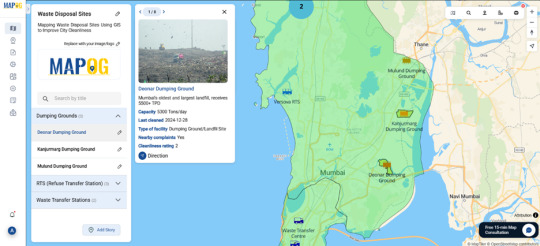
From Visualization to Real-World Improvements
Mapping waste disposal infrastructure isn't merely informative—it's transformative. Clearly visualizing waste management performance helps stakeholders prioritize critical areas, shape informed policies, and foster meaningful community engagement.Whether you’re an urban planner, government official, public health expert, researcher, NGO representative, or engaged citizen, MAPOG empowers you to turn complex waste management data into meaningful, impactful action. Because true progress in urban cleanliness begins with understanding the spatial stories behind the infrastructure.
0 notes
Text
Want to go from ArcGIS Pro 3 beginner to expert?
English Video tutorial, just FOR $9.99 (NORMAL price $19.9). Get it once and you will get endless access right.
🎯 This comprehensive guide teaches you essential GIS skills, including data visualization, spatial analysis, and map creation. Perfect for anyone looking to level up their GIS expertise with hands-on learning!
📌 Don't forget to like & subscribe for more GIS content!
0 notes